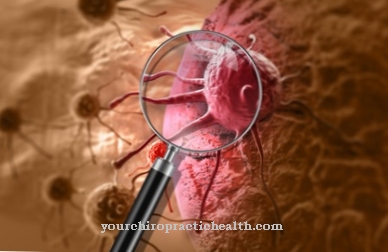Under the Stripping the vein doctor understands the surgical removal of varicose veins using a special probe. The diseased veins are pulled out of the affected area during stripping. One of the risks of the procedure is, in particular, lymph congestion due to injured lymph vessels.
What is the stripping?

Stripping is an operation to remove varicose veins. The procedure is also called Vein stripping known. This surgery is the standard therapy for treating patients with varicose veins. Varicose veins are nodular, enlarged veins. Usually the veins of the legs and their main trunks are affected by the phenomenon. Around 30 percent of all people suffer from varicose veins and thus have an increased risk of thrombosis and circulatory disorders.
The circulatory disorders can possibly damage the entire leg over time. The removal of varicose veins is usually essential because of these risks. Above all, varicose veins in the trunk are removed by surgical stripping. All enlarged and changed veins are taken from the superficial venous system. Stripping has been used since the beginning of the 20th century. In the meantime, however, there are also minimally invasive options for removing varicose veins. An example of such a method is the Chiva method.
Function, effect & goals
Stripping frees patients with varicose veins from nodular, enlarged veins. In order to determine a treatment method for varicose veins, the patient is first thoroughly examined by the vein specialist. This examination mainly includes ultrasound procedures and venous function tests. Patients whose internal leg veins are affected by functional disorders are unsuitable for stripping.
The same applies to patients whose varicose veins have a thrombotic cause. Stripping is generally not recommended even in the case of more severe general illnesses. For women during pregnancy, stripping is usually postponed in order to rule out any risks. If the decision to stripping has been made in the case of varicose veins, the patient is placed under general anesthesia, partial anesthesia or local anesthesia. Which form of anesthesia is used and whether hospitalization is required depends on the mental state of the patient and the severity of the findings.
Depending on the position of the varicose veins, the surgeon makes an incision around five centimeters long either in the groin or the hollow of the knee after the anesthesia. This incision serves as access to the venous system. Through the access, the doctor localizes the confluence of the knotted vein into the deep vein. This confluence is prevented. Confluence of smaller blood vessels into the affected region is also prevented. The doctor then inserts a special probe through the incision, which corresponds to a thin wire. This thin wire is pushed through the access into the diseased area. A second incision allows the wire to come out again. The affected vein is now attached to the probe. Only then does the actual stripping take place. The fixed vein is pulled down out of the leg.
Smaller side branches with pathological changes are then removed with tiny skin stitches. After the stripping, the doctor closes the access. Usually he uses a self-dissolving thread that is sewn under the skin. After stripping, the patient wears compression stumps for three to six weeks to prevent thrombosis. Usually there is also an anticoagulant treatment with heparin, which lasts for several days.
Varicose veins may develop again after stripping. According to studies, the relapse rate is related to the professionalism of the surgeon. Recurring varicose veins, for example, are often due to an incompletely removed trunk vein.
Risks, side effects & dangers
The stripping leaves visible scars as a two-inch incision is required for the operation. The incision is made in discrete regions, but the permanent scars still often lead patients to prefer minimally invasive treatments for varicose veins. Procedures like the Chiva method have a lot better than stripping in terms of scarring.
Like any other operation, stripping is associated with risks such as wound healing disorders, infections or bruises and the associated hardening. In addition to these conventional surgical and anesthetic risks, stripping also harbors risks such as lymph or nerve injuries. If the lymph vessels in the affected region are injured, the lymphatic fluid can, for example, become blocked. The leg swells as a result and the fluid may have to be drained off. If, on the other hand, nerves are injured during the operation, sensory disorders can occur in the affected area.
Mild numbness often occurs, but it usually resolves. Overall, the risk of complications from this operation is estimated to be extremely low. A slight pain may occur after the operation. Except for this phenomenon, side effects are extremely rare, as the operation is now a standard procedure. The risk of clots in the corresponding vein sections is kept low, for example, through procedures such as compression therapy.
Not wearing the compression stockings could, however, have serious consequences and promote thrombosis. Since self-dissolving sutures are usually used to close the incisions during stripping, the patient usually does not have to allow any sutures to be pulled after the operation. Nevertheless, there are follow-up appointments to check the wound healing.













.jpg)

.jpg)
.jpg)











.jpg)